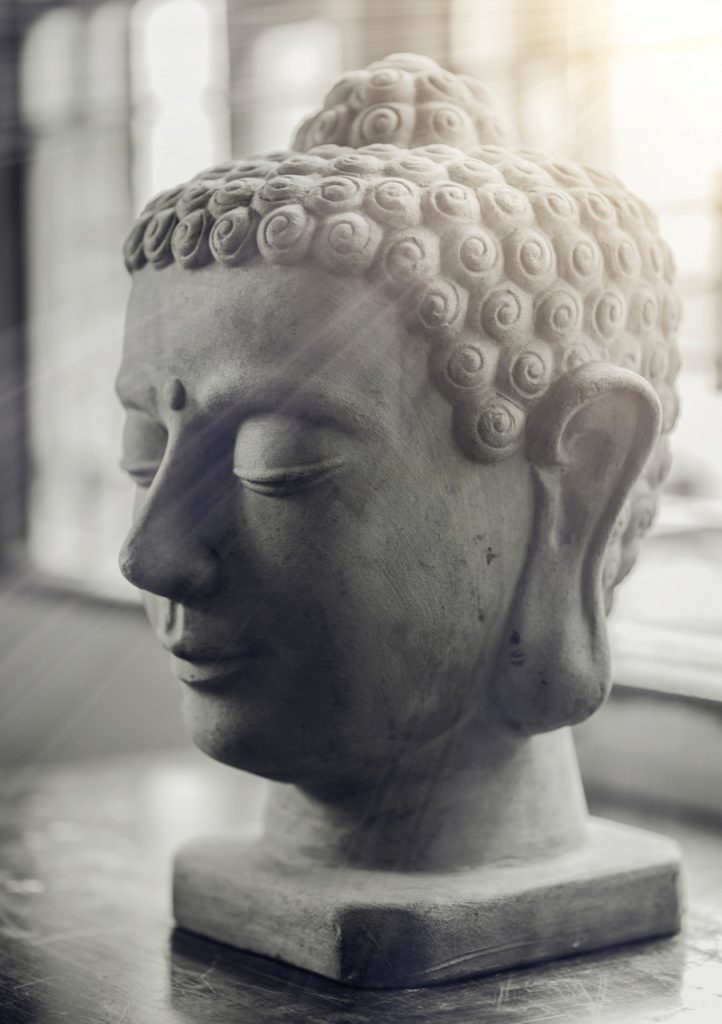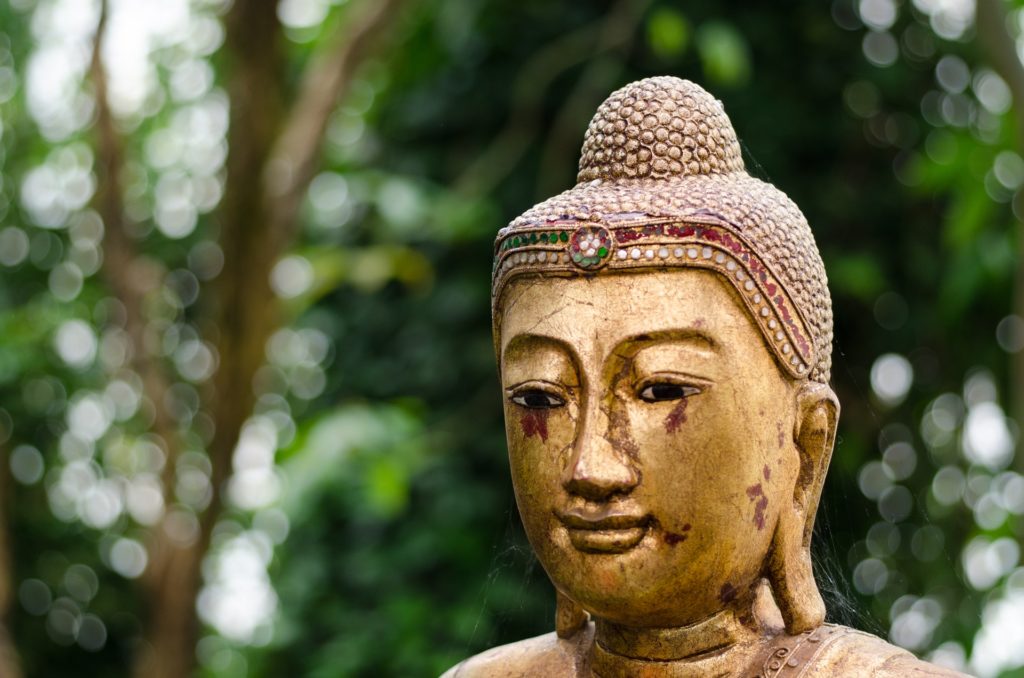
Prajna is insight or knowledge of the true nature of existence. The Buddhist tradition regards ignorance, a fundamental ignorance, misunderstanding or misperception of the nature of reality, as one of the basic causes of dukkha and samsara. By overcoming ignorance or misunderstanding one is enlightened and liberated. This overcoming includes awakening to impermanence and the non-self nature of reality, and this develops dispassion for the objects of clinging, and liberates a being from dukkha and saṃsāra. Prajñā is important in all Buddhist traditions and is the wisdom about the dharmas, functioning of karma and rebirths, realms of samsara, the impermanence of everything, no-self in anyone or anything, and dependent origination.
Origins
The origins of “liberating insight” are unclear. Bronkhorst states Buddhist texts do not describe it explicitly, and the content of “liberating insight” is likely not original to Buddhism. According to Vetter and Bronkhorst, this growing importance of “liberating insight” was a response to other religious groups in India, which held that a liberating insight was indispensable for moksha, liberation from rebirth.
Bronkhorst suggests that the conception of what exactly constituted “liberating insight” for Buddhists developed over time. Whereas originally it may not have been specified as an insight, later on, the Four Noble Truths served as such, to be superseded by pratityasamutpada, and still later, in the Hinayana schools, by the doctrine of the non-existence of a substantial self or person.
Other descriptions of this “liberating insight” exist in the Buddhist canon: that the five Skandhas are impermanent, disagreeable, and neither the Self nor belonging to oneself”; “the contemplation of the arising and disappearance (udayabbaya) of the five Skandhas”; “the realisation of the Skandhas as empty (rittaka), vain (tucchaka) and without any pith or substance (asaraka).
In the Pali Canon liberating insight is attained in the fourth dhyana. However, states Vetter, modern scholarship on the Pali Canon has uncovered a “whole series of inconsistencies in the transmission of the Buddha’s word”, and there are many conflicting versions of what constitutes higher knowledge and samadhi that leads to the liberation from rebirth and suffering. Even within the Four Dhyana methodology of meditation, Vetter notes that “penetrating abstract truths and penetrating them successively does not seem possible in a state of mind which is without contemplation and reflection.” According to Vetter, dhyāna itself constituted the original “liberating practice”.
Carol Anderson notes that insight is often depicted in the Vinaya as the opening of the Dhamma eye, which sets one on the Buddhist path to liberation.

Theravada
Vipassanā
In Theravada Buddhism, but also in Tibetan Buddhism, two types of meditation Buddhist practices are being followed, namely samatha (Pāli; Sanskrit: śamatha; “calm”) and vipassana (insight). Samatha is also called “calming meditation”, and was adopted into Buddhism from pre-Buddha Indian traditions. Vipassanā meditation was added by Buddha, and refers to “insight meditation”. Vipassana does not aim at peace and tranquillity, states Damien Keown, but “the generation of penetrating and critical insight (panna)”.
The focus of Vipassana meditation is to continuously and thoroughly know impermanence of everything (annica), no-Self in anything (anatta) and the dukkha teachings of Buddhism.
Contemporary Theravada orthodoxy regards samatha as a preparation for vipassanā, pacifying the mind and strengthening the concentration in order to allow the work of insight, which leads to liberation. In contrast, the Vipassana Movement argues that insight levels can be discerned without the need for developing samatha further due to the risks of going out of the course when strong samatha is developed.
Dependent arising
Pratityasamutpada, also called “dependent arising, or dependent origination”, is the Buddhist theory to explain the nature and relations of being, becoming, existence and ultimate reality. Buddhism asserts that there is nothing independent, except the state of nirvana. All physical and mental states depend on and arise from other pre-existing states, and in turn from them arise other dependent states while they cease.
The ‘dependent arisings’ have a causal conditioning, and thus Pratityasamutpada is the Buddhist belief that causality is the basis of ontology, not a creator God nor the ontological Vedic concept called universal Self (Brahman) nor any other ‘transcendent creative principle’. However, the Buddhist thought does not understand causality in terms of Newtonian mechanics, rather it understands it as conditioned arising. In Buddhism, dependent arising is referring to conditions created by a plurality of causes that necessarily co-originate a phenomenon within and across lifetimes, such as karma in one life creating conditions that lead to rebirth in one of the realms of existence for another lifetime.
Buddhism applies the dependent arising theory to explain the origination of endless cycles of dukkha and rebirth, through its Twelve Nidānas or “twelve links” doctrine. It states that because Avidyā (ignorance) exists Saṃskāras (karmic formations) exists, because Saṃskāras exists therefore Vijñāna (consciousness) exists, and in a similar manner it links Nāmarūpa (sentient body), Ṣaḍāyatana (six senses), Sparśa (sensory stimulation), Vedanā (feeling), Taṇhā (craving), Upādāna (grasping), Bhava (becoming), Jāti (birth), and Jarāmaraṇa (old age, death, sorrow, pain).
By breaking the circuitous links of the Twelve Nidanas, Buddhism asserts that liberation from these endless cycles of rebirth and dukkha can be attained.

Mahayana
Emptiness
Śūnyatā, or “emptiness”, is a central concept in Nagarjuna’s Madhyamaka school, and widely attested in the Prajñāpāramitā sutras. It brings together key Buddhist doctrines, particularly anatta and dependent origination, to refute the metaphysics of Sarvastivada and Sautrāntika (extinct non-Mahayana schools). Not only sentient beings are empty of ātman; all phenomena (dharmas) are without any svabhava (literally “own-nature” or “self-nature”), and thus without any underlying essence, and “empty” of being independent; thus the heterodox theories of svabhava circulating at the time were refuted on the basis of the doctrines of early Buddhism.
Representation
Sarvastivada teachings, which were criticized by Nāgārjuna, were reformulated by scholars such as Vasubandhu and Asanga and were adapted into the Yogachara school. One of the main features of Yogācāra philosophy is the concept of vijñapti-mātra. It is often used interchangeably with the term citta-mātra, but they have different meanings. The standard translation of both terms is “consciousness-only” or “mind-only.” Several modern researchers object to this translation and the accompanying label of “absolute idealism” or “idealistic monism”. A better translation for vijñapti-mātra is representation-only, while an alternative translation for citta (mind, thought) mātra (only, exclusively) has not been proposed.
While the Mādhyamaka school held that asserting the existence or non-existence of any ultimately real thing was inappropriate, some later exponents of Yogachara asserted that the mind and only the mind is ultimately real (a doctrine known as cittamatra). Vasubandhu and Asanga, however, did not assert that mind was truly existent, or the basis of all reality.
These two schools of thought, in opposition or synthesis, form the basis of subsequent Mahayana metaphysics in the Indo-Tibetan tradition.
Buddha-nature
Buddha-nature is a concept found in some 1st-millennium CE Buddhist texts, such as the Tathāgatagarbha sūtras. This concept has been controversial in Buddhism but has a following in East Asian Buddhism. These Sutras suggest, states Paul Williams, that ‘all sentient beings contain a Tathagata’ as their ‘essence, core inner nature, Self’. The Tathagatagarbha doctrine, at its earliest probably appeared about the later part of the 3rd century CE, and it contradicts the Anatta doctrine (non-Self) in a vast majority of Buddhist texts, leading scholars to posit that the Tathagatagarbha Sutras were written to promote Buddhism to non-Buddhists. However, the Buddhist text Ratnagotravibhāga states that the “Self” implied in Tathagatagarbha doctrine is actually “not-Self”.
